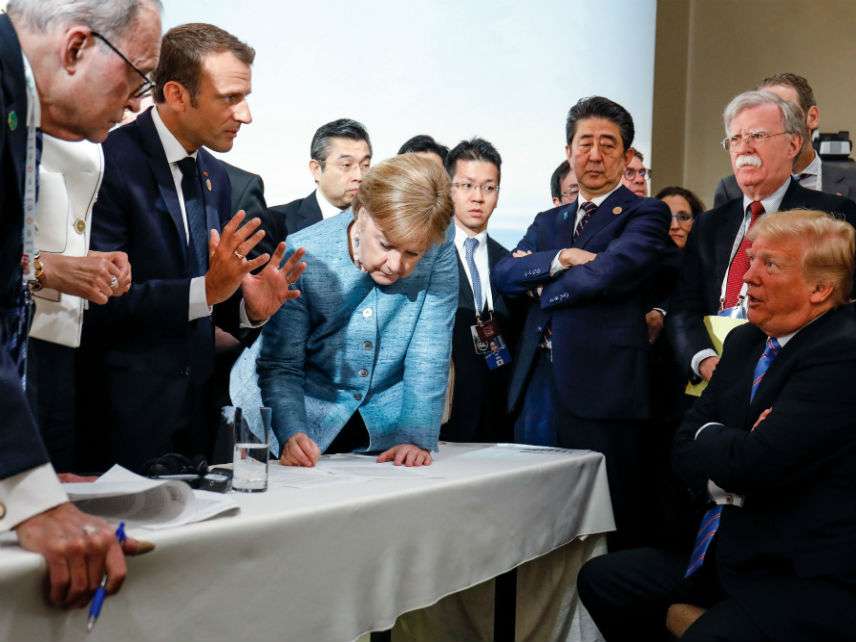Trump's Totally Free Trade Idea Is Really Smart
It's a damned shame that he doesn't seem to really believe in it.

At the G-7 summit meeting in Quebec, President Donald Trump reportedly suggested the idea of totally free trade to the leaders of Canada, Germany, Britain, France, Italy, and Japan. "Ultimately that's what you want, you want tariff free, no barriers, and you want no subsides because you have some countries subsidizing industries and that's not fair," Trump said. "So you go tariff free, you go barrier free, you go subsidy free, that's the way you learned at the Wharton School of Finance." Let's call that insight waging trade peace.
Well, hooray! Tariffs and other trade barriers are taxes on consumers and protections for the profits of uncompetitive corporations. So how high are tariffs now? According to the World Bank, U.S. tariffs applied to all products average about 1.6 percent. That happens to be the identical rate for Germany, France, Italy, and the United Kingdom. Japan's average is 1.3 percent and Canada's is the lowest at 0.8 percent. In other words, we and our allies are well down the path toward totally free trade.
Trump's salutary sentiment in favor of totally free trade was, however, swept away in a fit of Twitter pique at Canadian Prime Minister Justin Trudeau who rather mildly suggested that Canadians would retaliate against Trump's new tariffs on Canadian steel and aluminum. Miffed at the pushback from Trudeau, Trump tweeted, "Our Tariffs are in response to his of 270% on dairy!" As my Reason colleague Eric Boehm astutely points out, this tweet undermines the president's specious national security rationale for steel and aluminum tariffs.
The president's smart call to eliminate not only tariffs but also subsidies complicates his complaint about Canada's tariffs on American dairy products because the U.S. dairy sector is massively subsidized by the federal government. Americans for Tax Reform reported in 2012 that as a result of the federal government's system of dairy price supports the "U.S. prices for butter are twice that of world market prices, while cheese prices were 50 percent higher, and nonfat dry milk prices were 30% than world averages." Despite this distortion of market prices, U.S. dairy exports to Canada amount to about $300 million annually, or just under 0.09 percent of $341 billion in U.S. goods and services exported to Canada. Overall, the U.S. ran a trade surplus of $8.4 billion with our northern neighbor last year.
Eliminating tariffs, quotas, and subsidies would hugely benefit consumers not only in the U.S. but around the world. For example, a 2010 study by European economists estimating the effect of totally eliminating all trade barriers between the United States and the European Union found that that would boost incomes in the E.U. by as much as $86 billion and incomes in the U.S. by as much $82 billion annually. A 2016 study on the economic effects of broader free trade under the Trans-Pacific Partnership agreement (rejected by Trump) found that its adoption would have resulted in an increase in annual real incomes in the United States by $131 billion, or 0.5 percent of GDP, and an increase in annual exports by $357 billion, or 9.1 percent of exports, over baseline projections by 2030.
On the other hand, a 2017 World Bank study on the costs of protectionism estimated what would happen if countries around the world all increased their tariffs to the legal limits allowed under the World Trade Organization's rules. If that happened, global average tariff rates would more than triple from 2.7 percent to 10.2 percent. That increase would result in real income losses of 0.8 percent or more than $634 billion relative to baseline estimates after three years. In addition, global trade would fall by 9 percent or more than $2.6 trillion relative to baseline estimates by 2020. Overall, average incomes in the U.S. would be 0.4 percent lower in 2020 than they would otherwise have been.
During the 2016 presidential campaign, Trump threatened to impose a 45 percent tariff on foreign goods. In order to raise tariffs that high, the U.S. would have to withdraw entirely from the World Trade Organizaiton. In a 2017 study, Chinese economists modeled how such a huge across-the board-increase in tariffs would impact the U.S. economy. The results are not pretty. "The U.S. experiences the biggest welfare loss, and its real wages will drop by 2.2 percent," they estimated. In contrast, the real wages in China would fall a negligible 0.03 percent.
The evidence is conclusive that the U.S. loses hugely if the president launches a trade war and wins big if he chooses instead to wage trade peace.
Show Comments (121)